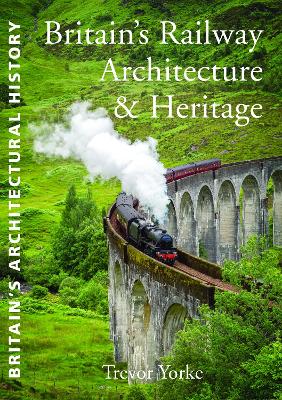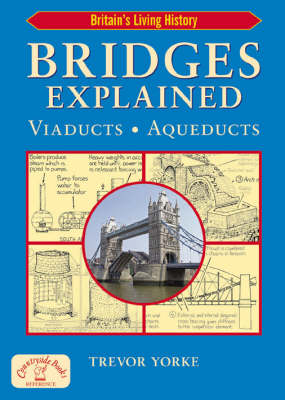Britain's Living History
3 total works
Get ready to travel back in time to the golden age of railways. This fully illustrated book, filled with photographs and detailed drawings, takes you on a journey to the majestic railway buildings of the 19th and early 20th century, exploring the architectural legacy they have left us.
The scale and ambition of these constructions reflected the pride of the railway companies who commissioned them.
The result was a raft of classically designed stations, mighty viaducts, tunnels and bridges, all of which inspired awe in a travelling public receptive to the splendour of a new kind of transport that was changing their lives.
Today, helped along by the popularity of preserved steam railways, these wonderful examples of architecture are widely appreciated for their beauty and the role they played in our social and industrial past.
In this book, author Trevor Yorke describes the huge range of buildings associated with the golden age of steam, including waiting rooms, booking halls, stations large and small, and hotels.
He explains the dynamics of their construction, the materials used and the myriad styles employed by leading architects and engineers of the day.
The scale and ambition of these constructions reflected the pride of the railway companies who commissioned them.
The result was a raft of classically designed stations, mighty viaducts, tunnels and bridges, all of which inspired awe in a travelling public receptive to the splendour of a new kind of transport that was changing their lives.
Today, helped along by the popularity of preserved steam railways, these wonderful examples of architecture are widely appreciated for their beauty and the role they played in our social and industrial past.
In this book, author Trevor Yorke describes the huge range of buildings associated with the golden age of steam, including waiting rooms, booking halls, stations large and small, and hotels.
He explains the dynamics of their construction, the materials used and the myriad styles employed by leading architects and engineers of the day.
Gothic style transformed the urban landscape from the mid 19th century. In this new book, discover how leading architects reinterpreted Medieval buildings to create a dynamic style which spread from Victorian England to the other side of the Atlantic. In this full colour illustrated guide the author uses his own drawings and photographs to show the reader some of the leading buildings of the time, and explain how to identify the style on more ordinary houses and how to recognise the details inside and out which characterise it. Trevor Yorke is a hugely popular artist and writer about architectural themes. His books include British Architectural Styles; Georgian & Regency Houses Explained , and Art Deco House Styles.
From the beautiful simplicity of an ancient clapper bridge to the elegant, sweeping lines of a modern suspension bridge, these structures delight the eye and complement their surroundings.
But what do we really know about them? Why and when were they built? What exactly does a particular part do? And, most importantly, why don't they fall down?
In this easy-to-follow book, Trevor Yorke uses his own illustrations, diagrams and photographs to explain the basic principles of construction and styles of bridges so the reader can better appreciate them, recognise how they work and from what period they date.
Along the way you'll take a closer look at arched bridges through the ages, from Roman & Medieval times to the Georgian era, as well as more modern cast-iron steel & concrete bridges. Beam, truss and girder bridges are explained in detail, as are cantilever structures, suspension bridges, moving bridges, aqueducts and viaducts.
Through diagrams and photos, the finest examples of each style and period are brought to life - for example, the first iteration of London Bridge, Sonning Bridge in Berkshire, Ironbridge in Shropshire, the Menai Suspension Bridge and many more.
Towards the back of the book you'll find a quick reference guide with a list of bridges to visit and a glossary to explain any unfamiliar terms.
You'll never look at another bridge in the same way again.
But what do we really know about them? Why and when were they built? What exactly does a particular part do? And, most importantly, why don't they fall down?
In this easy-to-follow book, Trevor Yorke uses his own illustrations, diagrams and photographs to explain the basic principles of construction and styles of bridges so the reader can better appreciate them, recognise how they work and from what period they date.
Along the way you'll take a closer look at arched bridges through the ages, from Roman & Medieval times to the Georgian era, as well as more modern cast-iron steel & concrete bridges. Beam, truss and girder bridges are explained in detail, as are cantilever structures, suspension bridges, moving bridges, aqueducts and viaducts.
Through diagrams and photos, the finest examples of each style and period are brought to life - for example, the first iteration of London Bridge, Sonning Bridge in Berkshire, Ironbridge in Shropshire, the Menai Suspension Bridge and many more.
Towards the back of the book you'll find a quick reference guide with a list of bridges to visit and a glossary to explain any unfamiliar terms.
You'll never look at another bridge in the same way again.


